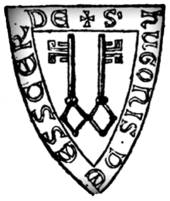Escherde (noble family)
Escherde is the name of an extinct, Lower Saxon noble family . The spelling differs in the course of the 12th and 13th centuries from Escerte, Esscherte, Eschere, Eskerte, Esscerte, Escerthe, Eskert to Escherde, which is very close to the name Escherode.
Headquarters
The family was named after the place Escherde, which was only a few kilometers away from the original diocese of Aulica ( Elze ) . The place existed in the Middle Ages as large and small Escherde or old and new Escherde. It was located on the important former Reichsstrasse No. 1, one of the most important military routes from west to east since the time of Charlemagne .
As Werner Wittich already explained in 1906, the Lords of Escherde were closely related to the family of the bailiffs of Hildesheim , who appeared under the names of Insula, von Insula-Werder , von Altenmarkt and bailiffs of the Bishop of Hildesheim and several monasteries, including from St. Michaelis and St. Moritz. The bailiwick of the St. Moritzstift at the gates of Hildesheim, located on the Moritzberg, was passed on to the Lords of Escherde, as did the bailiwick of the old town of Hildesheim later. Lippold I of Escherde was related by marriage to a daughter of Count Dietrich (Theodorich) von Werder-Emne, also with the second line from the house of the Counts of Insula-Werder, who were Counts of Ambergau. Only after the old line of the Counts of Insula-Werder had died out did the Counts of Wöltingerode-Woldenberg acquire county rights in most of the old Ambergau.
Von Escherde family
With Lippold I von Escherde, the family first appeared in a document from 1175 to 1229. At the same time as him, Johann von Escherde appeared (1183), presumably a brother or cousin of Lippold. Lippold's sons Dietrich (1203–1221) and Lippold junior II. (1202–1221) appeared when the family founded their own monastery, the Benedictine monastery Escherde .
Dietrich von Escherde had only one son named Johann II (1244), Lippold II, on the other hand, had six children, Lippold III. (1225-1260), Basilius (1225-1258), Dietrich II. (1236), Johann III. (1243-1260), Jutta (1229) and Ludold (f). While Lippold II followed his father as a lawyer and bailiff, his sister Jutta was married to Alard II von Walle and von Bremen, bailiff of the bishop of Bremen. Ludolf was Abbot of St. Godehard.
Lippold I von Escherde, who served a total of six bishops (Adelog, Berno, Konrad I, Hartbert, Siegfried I and Konrad II), was part of several counts in Saxony because of his prominent functions, his extensive property and his family ties , his marriage to the bailiffs of Bremen, Minden, Magdeburg etc. an important power factor in the diocese of Hildesheim. He was one of the leading ministerials of the diocese who rehearsed the uprising in 1221 on the occasion of the appointment of Bishop Konrad II and the accompanying early dismissal of Bishop Siegfried I.
However, since Bishop Konrad II was ordered by Emperor Friedrich II . was massively supported and sponsored, Lippold I. only had to make a good face for the bad game. In the years between 1223 and 1229 he had the bishop buy his share in Winzenburg Castle, the Baierturm, half a tithe and the Bailiwick of Elze, as well as those of Sarstedt etc.
After the death of Lippold II von Escherde, the importance of the family declined. Their track is lost in the course of the 14th century.
coat of arms
The coat of arms of the Lords of Escherde, two vertical keys facing outwards, is similar to the coat of arms of the Lords of Rosdorf . The almost identical coat of arms was also carried by the lords of Freden , lords of Bovenden , von Hardenberg and von Falkenberg , who were related to von Escherde .
The fact that this is not a coincidence is made clear by numerous documents that prove the common behavior of the families mentioned as well as the common possession. This is particularly evident in the diocese of Hildesheim, here in the former Ambergau , in and around the county of Winzenburg. These are the places Ammenhusen, Walden- or Woldenhusen, as well as the Sunderen forest, which lies between the two places.
literature
- Documents from the Bishops of Hildesheim, Vol. II., 1846
- Document book of the Hochstift Hildesheim, Bd. I u. II.
- Hermann Adolf Lüntzel - Older Diocese Hildesheim, 1837
- Hermann Adolf Lüntzel - History of the Diocese and City of Hildesheim Vol. I, II. 1858
- Hans Götting - The Diocese of Hildesheim 815 - 1221
- Contributions to the history of Hildesheim, Vol. I
- Franz Anton Blum - History of the Diocese of Hildesheim, 1805
- Joachim Barward Lauenstein - Historica Diplomatica Episcopatus Hildesiensis, 1740
- Reinhard Wenskus - Saxon tribal nobility and Franconian imperial nobility, 1976
- Friedrich Günther - The Ambergau, 1887
- Wolfgang Petke - The Counts of Wöltingerode-Wohldenberg, 1971
- Gustav Bode - Draft of a family tree for the Counts of Wöltingerode and the Counts of Werder and Emne, 1890
- Calenberg Document Book I - VII.
- Frederik D. Tunnat - The noble gentlemen from Rosdorf and their side branches, 2014
Individual evidence
- ^ Quarterly journal for social and economic history, Vol. IV, 1906, p. 97
- ^ UB Hochstift Hi. I.
- ^ UB Hochstift Hi I., 121
- ↑ UB Hochstift Hi I, 282,304,333,387,421,475 and Frederik D. Tunnat: The noble gentlemen of Rosdorf and their side branches, Berlin, pp. 71, 84ff, 108, 118
